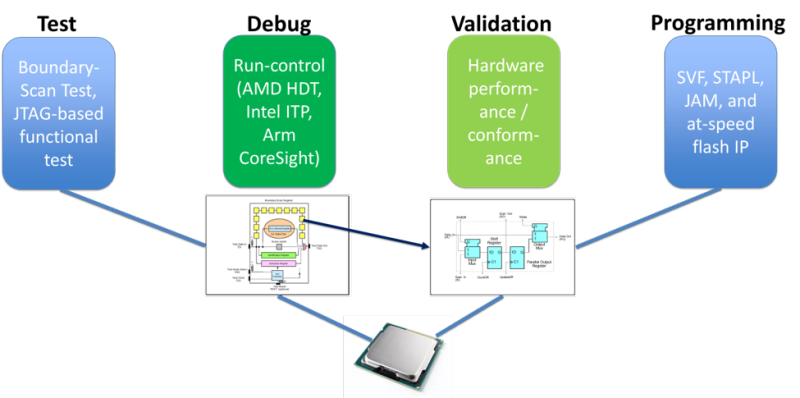Today, February 20th, 2025, marks the 35th anniversary of JTAG, also known as the Joint Test Action Group. With the first IEEE specification coming out in 1990, JTAG has become a foundational technology for silicon, hardware, firmware, and software test, validation, debug and programming. Let’s take a short stroll down memory lane, and see what lies ahead for JTAG.
In the late 1980s, the rapid advancement of integrated circuits posed significant challenges in testing and verifying the functionality of increasingly complex electronic systems. The traditional methods were proving insufficient, and there was a pressing need for a more efficient and reliable way to test these devices. Recognizing this, a consortium of leading electronics companies, including original representatives of ASSET (then part of Texas Instruments), formed the Joint Test Action Group, under the auspices of the IEEE.
Their collective efforts resulted in the development of the IEEE 1149.1 standard, which in turn became commonly known as JTAG. Officially adopted in 1990, this standard introduced a breakthrough method known as boundary-scan testing. By embedding test logic within the chips themselves, JTAG enabled engineers to test and diagnose faults in electronic assemblies without resorting to the intrusive “bed-of-nails” approach that had been the standard. All of this was enabled through the use of a basic state machine and boundary scan cells behind the pins of ICs:
The impact of JTAG on the electronics industry was immediate. By providing a standardized interface for testing and debugging, JTAG simplified the design and production processes for a wide range of electronic devices, from consumer electronics to aerospace systems. Boundary scan allowed for thorough testing of printed circuit boards (PCBs) without the need for physical access to every test point (i.e. bed of nails), reducing the time and cost associated with manual testing. That became enormously important as Ball Grid Array (BGA) technology emerged that provided no physical access to connections underneath the device – how were we to test boards with these kind of devices on them? The time and money saved over the last three decades has been enormous.
Over the past 35 years, JTAG has continuously evolved to meet the changing needs of the electronics industry. The original IEEE 1149.1 standard has been complemented by subsequent standards, such as IEEE 1149.6 for testing high-speed differential signals, and IEEE 1687, also known as IJTAG, for enhanced embedded instrumentation, providing access to memory BIST (MBIST), LBIST (Logic BIST) and Scan Test at the board level.
While JTAG is primarily known for its role in testing and debugging, its applications extend far beyond these areas. One notable application is in the field of device programming. JTAG provides a convenient and standardized method for programming flash memory and configuring programmable logic devices (PLDs) such as FPGAs.
Another significant application of JTAG is in system-level diagnostics. By leveraging embedded boundary-scan test and debugging capabilities, engineers can perform in-system testing and diagnostics, identifying faults and verifying system integrity without the need for external testing equipment. This is particularly valuable in mission-critical applications, where system reliability is paramount. You can read more about this on our ScanWorks Embedded Diagnostics webpage, and our press release.
And, of course, beyond test and programming, JTAG has become an access mechanism for powerful debug applications, such as debugging UEFI and Windows. Most recently, disruptive technology has been introduced for debugging of hypervisor technology, such as within the Windows Hyper-V environment and Secure Kernel. Check out our SourcePoint WinDbg page.
As we look to the future, it is clear that JTAG will continue to play a vital role in the electronics industry. The ongoing development of new standards and technologies promises to further enhance JTAG’s capabilities and extend its applications. For example, the integration of JTAG with advanced test and measurement techniques, such as machine learning and artificial intelligence, holds great potential for improving test and debug efficiency and accuracy. Using this technology to detect and mitigate vulnerabilities and malware in operating systems with billions of lines of code will become commonplace.
The 35th anniversary of JTAG is a testament to its enduring impact on the electronics industry. From its inception as a solution to the testing challenges of the late 20th century, JTAG has evolved into a versatile and indispensable tool for engineers and designers worldwide.
JTAG’s journey is a story of collaboration, innovation, and relentless pursuit of excellence. It stands as a reminder of what can be achieved when industry leaders come together to solve common challenges, and ASSET is proud to have participated in this journey.
Want to know more? Here’s a few suggested background reading content and eBooks:
Boundary Scan Test: https://www.asset-intertech.com/resources/eresources/ieee-1149-1-jtag-and-boundary-scan-tutorial-second-edition/
UEFI/Windows Debug: https://www.asset-intertech.com/resources/academy/sourcepoint-academy/
Platform Validation: https://www.asset-intertech.com/resources/eresources/guidelines-for-system-level-jtag-design/



